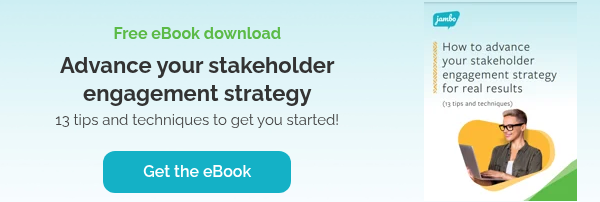
A Stakeholder Relationship Management (SRM) software can help improve stakeholder experience by ensuring that your stakeholder information is streamlined, organized, traceable, and continuously updated. Remember, a positive stakeholder experience can significantly impact the success of your projects and your organization as a whole.
This post provides a detailed overview of four tips to enhance your stakeholders' experience with the aid of Jambo Stakeholder Relationship Management (SRM) software.
4 tips to improve your stakeholders' experience with Stakeholder Relationship Management (SRM) software
Here are four tips to improve your stakeholders' experience with Jambo Stakeholder Relationship Management (SRM) software:
Tip #1: Communicate with your stakeholders early on
You often won't need to engage each stakeholder in the same ways. To learn who needs to be involved the most, we recommend starting with a mapping exercise.
Want to learn how to do a stakeholder mapping exercise? Check out our blog
Once you know who you'll be engaging with and have planned your engagement strategy, begin communicating with your stakeholders immediately. This way, you can be confident that your stakeholders hear your key messages directly from your organization, rather than through social media or news reports.
How does this improve a stakeholder's experience with your organization?
First impressions are vital because they can set the tone for how your stakeholders view you, your project and your organization. By taking the time to ensure that your organization communicates directly with stakeholders from the outset, you'll help them feel included and respected from the start of the relationship.
How does an SRM help?
Streamlined and organized information: With a Jambo SRM, you can track all your stakeholder engagements within the software. This keeps everything organized and streamlined, so you're quickly updated and can track who's being engaged, who's been left out and which strategic steps should be taken next.
Tip #2: Use two-way communication
Stakeholder engagement is a collaborative process. The perspectives shared by your stakeholders can strengthen your project and your organization; therefore, ensure they know how to contact you or your organization with any questions, comments, or concerns.
While you might feel confident that your stakeholders will feel more included and respected simply by you reaching out to them, make sure they also know how to contact you, as they'll likely have feedback to share.
You can achieve this by using two-way communication, which enables you to reach out to your stakeholders through a channel that allows them to respond to you as well.
How does this improve a stakeholder's experience with your organization?
This demonstrates to your stakeholders that your organization isn't just interested in pushing an agenda but is also willing to work with them and genuinely wants to hear their perspectives. Not only will this build trust in your organization, but it will also help your stakeholders understand that you're genuinely interested in their input and willing to consider their perspectives.
How does an SRM help?
Communication management: With Jambo SRM software, you can quickly create communication records for each interaction with your stakeholders and log them as phone calls, emails, meetings, and more, so you know exactly how you and your team have been engaging.
In Jambo, you can add notes/comments to track any additional information you'd like to follow (like whether stakeholders have been given a specific email or number to use to contact your organization). This makes it easier to see how stakeholders are being engaged and whether they've been given the information they might need for a positive experience with your organization.
With Jambo, we also encourage our users to log their stakeholders' preferences in the dedicated notes/comments section (like how they'd like to be communicated with). As not everyone enjoys communicating in the same way, having this information logged in your SRM will help ensure your organization engages in the best way possible, keeping everyone on the same page.
Tip #3: Take all issues and commitments seriously
As your project continues, you'll likely encounter stakeholder issues and commitments. While these can easily fall to the side as other essential tasks and obligations arise, you must take every issue and commitment seriously (even those that can't be completed for years). You and your team can easily browse a stakeholder's profile to quickly identify any issues or commitments associated with that stakeholder. This stakeholder-centric approach enables your team to collaborate effectively, whether they're seasoned professionals or new to the team.
How does this improve a stakeholder's experience with your organization?
Issues: When it comes to issues, stakeholders often raise concerns or questions about your project (e.g., where it's operating, who it's impacting, cost, environmental impact, etc.).
While they can increase risks and complications, issues are also an opportunity for you to demonstrate to your stakeholders that you're listening to them, taking their perspectives seriously, and are willing to work with them.
By working to fulfill all your stakeholders ' issues, your organization will be remembered for its willingness to engage with them transparently and respectfully, even if they don't get the outcome they originally wanted. This can increase their trust in your organization and ensure they'll come to you with any future concerns or questions (instead of taking to social media).
Commitments: In their basic form, commitments are promises made by your organization to a stakeholder to take a specific action.
Like issues, your organization's willingness to fulfill stakeholders' commitments will make them feel acknowledged and respected, helping to strengthen the relationship and keep those communication channels open for future engagements and more positive outcomes.
How does Jambo SRM software help?
With Jambo SRM software, your issues and commitments are organized and easier to understand, so you never forget or miss any of them.
In Jambo, all your stakeholder information is connected (i.e., traceable), so you can quickly access a stakeholder profile before meeting with them to review any outstanding issues or commitments. This way, nothing is left unaddressed or ignored!
Want to learn how SRM traceability enhances your stakeholder engagement? Check out our blog!
Tip #4: Keep stakeholders updated continuously
When we get busy, it's easy to forget to check in with our stakeholders regarding updates; however, this is a crucial part of building a positive stakeholder experience.
How does this improve a stakeholder's experience with your organization?
When stakeholders are kept informed about your project, they understand that they can count on you for transparency and consistent communication. This consistency is key for an excellent stakeholder experience because they know your organization will prioritize them, and they can rely on you for updates.
How does an SRM help?
In an SRM, you have your entire engagement history logged, allowing you to trace back and see what your stakeholders care about easily and when they were last engaged. This is particularly useful for teams with members joining or leaving mid-project, or sharing engagement responsibilities. Teams can simply navigate to a stakeholder's profile and easily view the history of engagement, then determine the next steps.
In Jambo, you can search through individual profiles if you're looking for updates on a specific stakeholder, or you can effortlessly search keywords or run targeted reports to help you understand which stakeholder might need to be updated next.
Bonus Tips:
Updates coming from your organization
When stakeholders cannot rely on an organization for updates, they'll seek information elsewhere. This leaves your organization open to risks because stakeholders may seek information from the rumour mill or from another organization competing with you, harming your reputation and spreading misinformation.
Instead, by choosing to offer consistent updates, you get to communicate your key messages in a relevant and practical way directly to your stakeholders.
No news can still be news.
Don't forget to let relevant stakeholders know when there are no updates. For example, if you have a stakeholder who has been waiting and inquiring about a specific update in your project, but it hasn't occurred yet, it can be a positive experience for that stakeholder to hear from you anyway.
You can quickly let them know you haven't forgotten about them, but that there just hasn't been any progress on that task just yet. While this isn't always necessary, please use your best judgment. If there's a stakeholder who hasn't heard from your organization for a while, consider checking in.
Jambo Stakeholder Relationship Management (SRM) software for a better experience
A quality SRM can help you enhance the experience of stakeholders with your organization by streamlining and organizing your stakeholder management process. This makes it easy for you and your team to understand how your organization is communicating and where there might be room for improvement.
Helping organizations improve their stakeholder relationships has been a key focus for the Jambo team since the start of our Stakeholder Relationship Management (SRM) journey. We designed our SRM, Jambo, to meet the stakeholder management and relationship needs of users now and into the future.
To gain a quick overview of what Jambo can do for your organization, check out our 1-minute explainer video by clicking the image below! If you have any questions about our SRM or would like to discuss stakeholder engagement, book a demo with Jambo.










